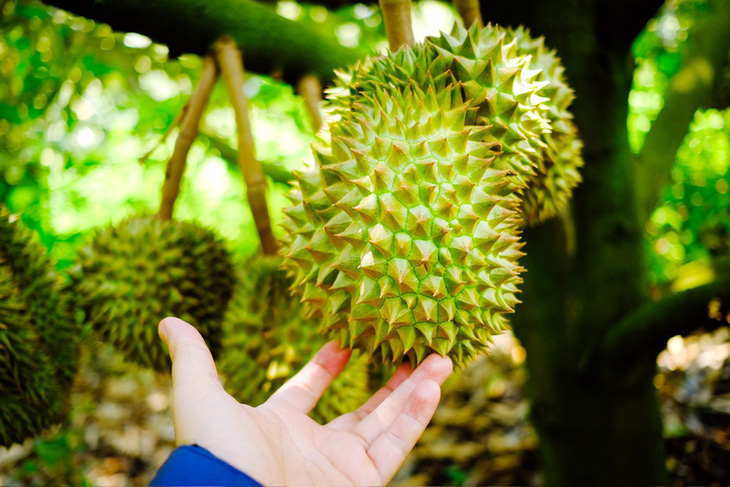Although experts have warned, many farmers believe that durian prices will remain high in the near future because supply does not meet demand. Durian prices have increased, farmers in many localities are scrambling to destroy pepper and rubber gardens… to grow durian.
According to the Ministry of Agriculture and Rural Development, the domestic durian growing area is about 110,000 hectares, with a growth rate of 24% per year. Among them, the Central Highlands is the region with the largest area with more than 51,000 hectares. Next is the Southwest with 33,000 hectares and the Southeast with nearly 21,000 hectares.


Not worried about lack of output for durian fruit?
With the price of durian rising recently, many farmers in Ea Bar commune (Song Hinh district, Phu Yen province) are “brutally” cutting down pepper, coffee, rubber… to grow durian. Mr. Nguyen Ngoc Hieu (57 years old, residing in Chu Bloi village, Ea Bar commune), owner of a 4ha durian garden with 550 trees, said that this land used to be planted with pepper and coffee but the economic efficiency was not high and the selling price was unstable. Because of this, he decided to cut down the entire area and switch to growing durian.
“For the time being, I see that durian has a good price and the red soil of Ea Bar commune is very suitable for growing durian trees. In terms of economic value, durian is superior to coffee and pepper. For example, about 10 durian trees, the value is equal to 1 hectare of pepper. In addition, fertilizer and medicine to care for durian trees are still cheaper than other types of trees, so I am determined to cut down all coffee and pepper to convert to growing durian. Although durian’s price is low at times, it is still higher than other types of trees,” Mr. Hieu said.
Ms. Tran Thi Bich Hoa (40 years old, residing in Ea Mkeng village, Ea Bar commune) said that she and her husband are planting 120 durian trees on an area of 1 hectare of land. Previously, this land area was used to grow cassava, but this crop had too low economic efficiency, so she and her husband decided to destroy it and switch to growing durian. “People up here grow a lot of durian, most of them cut down coffee, pepper… to grow durian. Durian has a good price and good harvest, so everyone is chasing this tree,” Ms. Hoa said.
Mr. Dinh Ngoc Dan, Chairman of Song Hinh District People’s Committee, said that currently there are about 500 hectares of durian growing in the district. Many households have switched from growing short-term crops such as sugarcane, cassava, pepper, coffee… to growing durian in the hope of improving the economy. “We have grasped the fact that people are massively switching to durian growing.
However, many businesses come to work with the district to place orders to buy durians, while the durian harvest area is not much, so we are not worried about lack of output,” Mr. Dan said.
Durian prices will remain high for many more years?
Mr. Hoang Van Chon, a farmer growing nearly 100 hectares of durian in Duc Co district (Gia Lai), said that there is no need to worry about prices, because the supply is still not enough for domestic and export demand.
In the future, although supply increases to meet demand, durian prices will continue to remain high. “In addition, besides the Chinese market, the agricultural industry is exploring exports to India. Although it takes time for the market to respond, once Indians eat durian, the export market will be even larger,” Mr. Choose is optimistic.
According to Mr. Chon, as long as durian prices reach 40,000 – 50,000 VND/kg, growers will be more profitable than many other agricultural products, not to mention the current market price fluctuating at 100,000 VND/kg. Many other farmers also said that they do not have to worry about oversupply of durian because Vietnam’s durian harvest season is spread out over many months, not concentrated at the same time, so there is no need to worry about congestion. For example, durian season comes early in the West, then in the East and finally in the Central Highlands.
Many farmers believe that instead of worrying about output, management agencies need to promote support for sustainable production, bringing Vietnamese durian into the export chain. In particular, facilitate and quickly issue planting area codes, support farmers with planting techniques according to VietGAP and GlobalGAP standards. Helping durian fruit expand export routes, continuing to be an agricultural product that brings billions of dollars to Vietnam. Avoid the situation where farmers have to rush to buy planting area codes, which is both a violation of regulations and unsustainable.
According to the Department of Crop Production and Plant Protection of Gia Lai province, many farmers in the area intercrop pepper, coffee and other crops for short-term survival. If next time, durian prices are still good, they will gradually change or vice versa. Intercropping helps farmers harvest two products at the same time, minimizing risks.
“Durian trees take four years to harvest, so people are very reluctant to destroy coffee to convert. Monoculture cultivation mostly belongs to large businesses or farmers with strong financial capacity,” said a leader of this agency.
According to NGUYEN HOANG – TAN LUC (Tuoi Tre newspaper)

